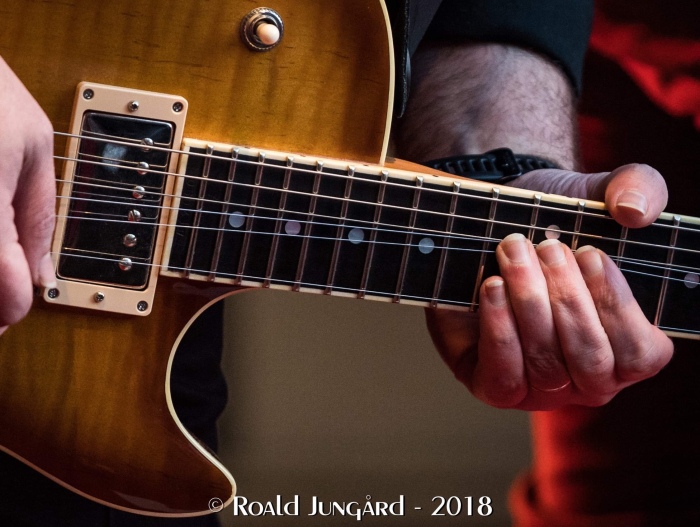
GUITARS:
WILSON ROSE CUSTOM GUITARS SINGLECUT
My favorite guitar, made by Sam Prace from BP Rose Guitars and Kurt Wilson from Kurt Wilson Guitars. It’s semi hollow with a chambered mahogany back and neck with a flame maple top and ebony fingerboard. The pickups are custom wound Lindy Fralin humbuckers. I’ve replaced the frets with gigantic Jescar stainless 58118 fretwire because I like the smoothness or bending on them, but I haven’t otherwise modified this guitar as much as most of my others. I’m not usually a flame top guy, but this one was subtle enough and too beautiful to pass up.
GRETSCH G5438 ELECTROMATIC PRO JET
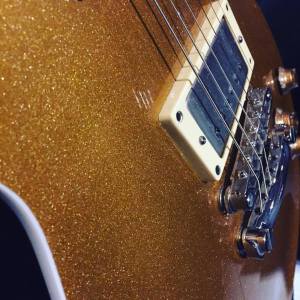 This was my main guitar for a couple of years until I found my Wilson Rose, a Gretsch from their import Electromatic series that I modified to do some very un-Gretsch things. My ES-333 was previously becoming my main guitar, but big guitars suck to travel on airplanes with, so I went on the lookout for a more compact guitar with humbuckers and the slinkier 24.75″ scale length of the Gibson. This guitar fit the bill perfectly, and unlike some of the other solidbodied Gibson, Epiphone, ESP, and PRS guitars I tried in my price range, the Gretsch has a a chambered body that makes it fairly light weight and gives it an airier resonance more like my 333. I replaced the pickups with the same Lollar Imperial humbuckers that I have in my 333 (that’s a Low Wind neck and a Regular Wind bridge), replaced the frets with my favorite giant stainless steel Jescar frets for easier bending, and wired it with master volume, master tone, a push pull phase switch, and a Fralin blender pot.
This was my main guitar for a couple of years until I found my Wilson Rose, a Gretsch from their import Electromatic series that I modified to do some very un-Gretsch things. My ES-333 was previously becoming my main guitar, but big guitars suck to travel on airplanes with, so I went on the lookout for a more compact guitar with humbuckers and the slinkier 24.75″ scale length of the Gibson. This guitar fit the bill perfectly, and unlike some of the other solidbodied Gibson, Epiphone, ESP, and PRS guitars I tried in my price range, the Gretsch has a a chambered body that makes it fairly light weight and gives it an airier resonance more like my 333. I replaced the pickups with the same Lollar Imperial humbuckers that I have in my 333 (that’s a Low Wind neck and a Regular Wind bridge), replaced the frets with my favorite giant stainless steel Jescar frets for easier bending, and wired it with master volume, master tone, a push pull phase switch, and a Fralin blender pot.
THE BLUE STRAT
This was my main guitar for years since I bought it in 1992, although I’m not really using it these days except for special occasions. If you’ve heard any of my older recorded work, it’s probably this guitar, as it’s the only guitar on These Blues Are Mine, it’s on all but two songs on Axe to Grind, a little more than half of Catch Me, all of Adding Insight To Injury, all of Cryin’ Hey, most of Just Like It Is, most of Sugar Ray and the Bluetones Featuring Monster Mike Welch and My Life My Friends My Music, and all of Evening, as well as a bunch of my guest appearances on other people’s CDs. For the non-technically minded, it’s a Fender Stratocaster, but if you’re interested in the nitty gritty, here goes:
– 1992 Fender Japan reissue body, basswood, routed out under pickguard for resonance and weight reduction. Between the basswood and the additional resonating chamber, the Blue Strat has a different midrange character than most off-the-shelf Stratocasters, but it’s got a ton of high end sparkle on top as well.
– Lindy Fralin pickups, measuring 6K (neck), 6.1 K (middle) and 7k (bridge). The bridge pickup has a metal baseplate like that of a Telecaster, also by Lindy Fralin. The baseplate gives the bridge pickup a nice mix of the subtlety and “wiriness” of a Strat pickup with the fat mids and explosive high end of a Tele pickup.
– USA Custom Guitars neck, maple, “boatneck” contour (measuring 1″ deep all the way down), with Dunlop 6000 frets and a 7.25″ to 9″ compound fingerboard radius. The big “V” neck and tall frets give a lot of support for bending strings and playing for long periods of time.
– Callaham bridge assembly
– Sperzel locking tuners – these are great for quick string changes.
– Electronics: 5 way switch, master volume, master tone, Lindy Fralin blender knob, push-pull phase switch for bridge pickup
THE RED TELECASTER
When it comes to Fenders, I’m actually playing this guitar more than I am the blue Strat recently. With its killer Lollar pickups, it’s thicker and more appealing sounding through most amps, and it doesn’t have the sentimental value that keeps me from carrying the Blue Strat onto airplanes.
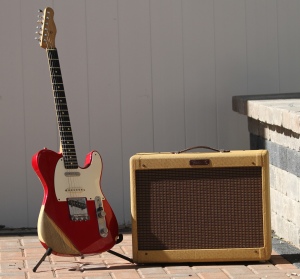
– Fender Muddy Waters Telecaster body, with crudely hand-sanded contours to try to make it hang a little more like a Strat (update: the finish around the “contours” has been lifting off in big chunks; you can see the results in the “family portrait” at the top of the page)
– USA Custom Guitars boatneck – same specs as the Blue Strat, but a Dark Indian Rosewood fretboard and Jescar stainless frets (same size as Dunlop 6000)
– Jason Lollar pickups (Vintage Tele neck, Blackface Strat middle, and Special Tele bridge). I cannot say enough good things about every Lollar pickup I’ve tried. (Update: I replaced the neck and middle pickups with a single Lollar Low Wind Imperial humbucker. I love it, but I also loved it before, and reserve the right to go back. Again, see the results at the top of the page)
– Sperzel tuners
– Callaham compensated saddles
GIBSON ES-333
With Lollar Imperial pickups (Low Wind neck/Regular Wind bridge). The 333 is basically a cheaper satin-finished ES-335, and I love the faded cherry on a plain top – it looks and feels way more like an old 335 than a lot of the highly flamed glossy modern production guitars do. The Lollars are great – for fat, round sounding humbuckers, they’re clear enough that I can play anything I play on my other guitars without worrying about mushing out. I also put giant stainless steel frets on this guitar for easier string bending. (Photo by Randy MacDonald)
THE OTHER BLUE STRAT
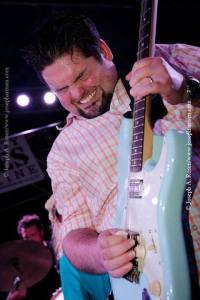 This is a parts guitar that I put together around Jason Lollar’s insanely great Lollartron pickups because I was playing the Gretsch 5420 so much (see below), and I wanted a more portable, familiar solidbody guitar to travel with that had some of the Gretsch vibe. I ended up with a completely unique, twangy, and fat sounding instrument that can be heard on the Mannish Boys’ Wrapped Up and Ready. Currently this guitar is set up for slide with heavier strings and higher action. (photo by Joseph A. Rosen)
This is a parts guitar that I put together around Jason Lollar’s insanely great Lollartron pickups because I was playing the Gretsch 5420 so much (see below), and I wanted a more portable, familiar solidbody guitar to travel with that had some of the Gretsch vibe. I ended up with a completely unique, twangy, and fat sounding instrument that can be heard on the Mannish Boys’ Wrapped Up and Ready. Currently this guitar is set up for slide with heavier strings and higher action. (photo by Joseph A. Rosen)
– USA Custom basswood Strat body
– USA Custom Tele boatneck, rosewood fretboard, boat shape, 7.25-9.5 compound radius, Dunlop 6000 fretwire
– Jason Lollar Lollartron pickups
GRETSCH G5420T
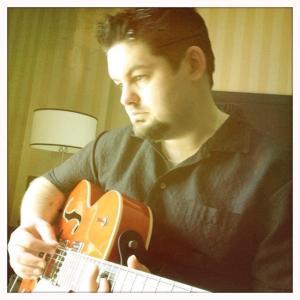 As a Beatlemaniac, I’ve always wanted a Gretsch, but the guitars in my price range always had generic, non-Gretsch sounding pickups that didn’t appeal to me at all. Last year, Gretsch revamped their budget Electromatic line with “blacktop” Filtertron pickups that give that great, shimmery, twangy Gretsch tone. I bought this thinking it wouldn’t become a main guitar, but as soon as I got it, I brought it to the studio and used it on four songs on Duke Robillard’s Independently Blue, and I’ve been using it live ever since. Sugar Ray and the Bluetones’ Living From Tear to Tear features the Gretsch on nine of the twelve songs and the red Tele on the rest. The only changes I’ve made are a brass Compton bridge and a treble bleed cap on the master volume control.
As a Beatlemaniac, I’ve always wanted a Gretsch, but the guitars in my price range always had generic, non-Gretsch sounding pickups that didn’t appeal to me at all. Last year, Gretsch revamped their budget Electromatic line with “blacktop” Filtertron pickups that give that great, shimmery, twangy Gretsch tone. I bought this thinking it wouldn’t become a main guitar, but as soon as I got it, I brought it to the studio and used it on four songs on Duke Robillard’s Independently Blue, and I’ve been using it live ever since. Sugar Ray and the Bluetones’ Living From Tear to Tear features the Gretsch on nine of the twelve songs and the red Tele on the rest. The only changes I’ve made are a brass Compton bridge and a treble bleed cap on the master volume control.
RECORDING KING ROS-16 – This is one of my favorite guitars right now – it’s an import 12-fret Martin 000 copy with a beautiful sound and a nice, old-style V shaped neck. I have an LR Baggs Anthem SL pickup in it.
Here’s another favorite guitar, with beautiful, clear sounding minihumbuckers. I think that might be part of the reason Strat players like Magic Sam and Otis Rush gravitated towards the Riviera; the minihumbuckers give clarity not unlike a Fender to an acoustically warm, Gibson-styled guitar.
AMPLIFIERS
A quick caveat that I use backline amps a lot on the road. I usually ask for a reissue Twin Reverb.
Quilter MicroPro Mach 2 HD combo – it took a while for me to dial it in, but I’m very happy with this lightweight solid state combo these days.
Fender Princeton Reverb (1970s?) – When I bought it, someone had put this in a reissue blackface cabinet with a 12″ speaker. I changed the speaker to a Celestion Alnico Blue. This is my main amp to record with – you can hear it on Anthony Geraci’s Fifty Shades of Blue, the Knickerbocker All-Stars’ Go Back Home to the Blues, and the upcoming Sugar Ray and the Bluetones album – but it’s developed a habit of dying and then magically coming to life when I bring it to the repair shop.
Fender Pro Reverb (1966, blackface)- This was my main amp for years. It’s one of my favorite sounds ever, and after a few years in semi-retirement, it’s become my main live amp again. Now that I have my pedal situation sorted out, I don’t have the same volume problems I used to, and I can enjoy the presence and room-filling quality of this amp without being loud.
Fender Pro Junior (1996) – heavily modified. The chassis is largely untouched – Pro Juniors are the best amps Fender makes in the under-$2000 price bracket – but everything else is non-stock. The cabinet has been replaced by a larger finger-jointed solid pine cabinet by JD Newell Custom Cabs, and the speaker by a 12″ Eminence Legend. I put a New Old Stock RCA 12AY7 tube in the first position to lower the gain and reduce the breakup, which has the added benefit of making the clean tones deeper and more three-dimensional. This is the amp on Sugar Ray and the Bluetones’ Living Tear to Tear and Duke Robillard’s Independently Blue.
Fender 59 LTD Bassman reissue (2010) – I replaced the first preamp tube with a 12AY7 to bring the gain down, but everything else is stock.
Victoria Victoriette (2005) – A great little amp. 20 watts of 6V6 power, mismatched speakers (12″ and 10″, one each), great reverb and trem.
So much of my playing is done in fly-in situations where I have to use back line gear that I consider it a luxury to get to use any of these, really.
EFFECTS
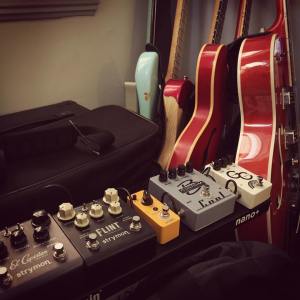
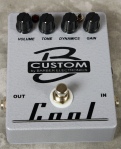 – Barber B-Custom Cool overdrive. It’s a huge change for me to even have pedals in line, but David Barber (www.barberelectronics.com) and Ronni Santmyer are unbelievable geniuses. I needed an overdrive pedal for some of the overseas gigs, because unfamiliar rental amps are just about always too loud for any room (even a festival). I tried a couple of great Barber pedals, which were close to what I wanted, but I contacted David to see if he could tweak a pedal to my tastes. He and Ronni not only rose to the occasion, but went above and beyond in creating the best overdrive pedal I’ve heard for what I do. (Emphasis on “for what I do” – there are other great overdrive pedals out there!). I’m even keeping this thing in line at local gigs with my own amps, using it to fine tune the bass response and breakup, to the point where I consider it a part of the amp.
– Barber B-Custom Cool overdrive. It’s a huge change for me to even have pedals in line, but David Barber (www.barberelectronics.com) and Ronni Santmyer are unbelievable geniuses. I needed an overdrive pedal for some of the overseas gigs, because unfamiliar rental amps are just about always too loud for any room (even a festival). I tried a couple of great Barber pedals, which were close to what I wanted, but I contacted David to see if he could tweak a pedal to my tastes. He and Ronni not only rose to the occasion, but went above and beyond in creating the best overdrive pedal I’ve heard for what I do. (Emphasis on “for what I do” – there are other great overdrive pedals out there!). I’m even keeping this thing in line at local gigs with my own amps, using it to fine tune the bass response and breakup, to the point where I consider it a part of the amp.
I asked him for the openness and clarity of his LTD SR pedal, but I liked the “dynamics” control on his Small Fry, which allows you to add compression like an amp does when it’s turned up. They came up with something better than either, frankly.
The controls of the Custom Cool are volume, tone, dynamics, and gain, left to right. There’s also a mini-toggle for clipping symmetry that I keep in the center for the clearest sound, and internal trimpots controlling Bass (I keep it halfway), Mids (I scoop ’em out altogether – there’s enough midrange in my touch), Note Shape (a pre-OD bass control that I keep halfway up, and presence (all the way off – again, my touch and gear don’t need added treble!)
I also have a Barber Gain Changer I like a lot, and other overdrives and distortions I have fun pulling out from time to time, but the Custom Cool is the cornerstone of my tone.
– Barber Tone Press Compact compressor – I use this after the overdrive to even out levels and increase sustain without needing more dirt.
– Strymon Flint reverb/tremolo – I’m even using this one instead of the built-in reverb and tremolo in my blackface Fender amps. It’s really nice.
– Sonic Research Turbo Tuner or Boss TU-3
STRINGS
Curt Mangan nickel plated steel wound. My usual set for a long time was 10.5, 12.5, 16.5, 26, 36, 46, but after taking a break recently, I went down to 8.5, 10.5, 14, 22, 32, 42 when I started playing again.
OTHER
D’Andrea Pro Plec 310 picks, Planet Waves NS Pro Capo, and double cut real bottlenecks by Delta Slider and Big Heart.
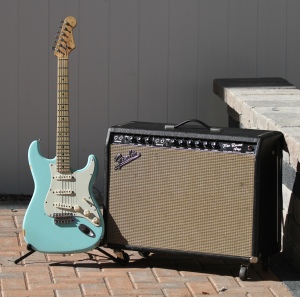
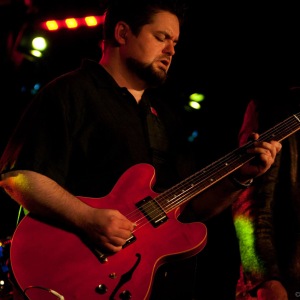

Mike, when are you coming over to the UK?, I need to see you live!. Otis Grand very kindly guested at a gig of mine a few years ago (he is another hero to me) and I am always blown away by his playing. You are much the same in approach in my mind, very classic, very tasty and when you need to, you can destroy everyone on stage with your intensity.
Please make arrangements to get over to London sometime, be great to see you live 9easier said than done I know, but just trying to ‘will it’ to happen:)
Best
Matt Bullard
The UK is tough; there’s been interest but not a lot of offers of enough money to justify a tour. Thanks for the incredibly nice words, and if the UK situation changes, I’ll post it here as soon as it happens!
I wouldn’t mind if you dropped by in Norway, when (if) you first cross the pond….?
Always great tone, Mike, really enjoy your playing.
Thanks!
Mike; I’fe been a fan since the first record. You have such great tone and feel. I really love yurt playing. Hope 2 catch you in Oklahoma this summer on the festival time.
Thanx
Scott springfield
Hi Mike,im currently living in vermont but im from boston,i’ve seen you dozens of times including many times at Ed Burkes so i go way back,most recently i saw you at johnny d’s last yr on a visit to boston.I had a gear question for you,i have a victoria ivy league,an ep booster and a nice strat,im looking for an overdrive pedal to compliment this set up,would your b custom cool pedal work well with my setup,im trying to get a blues band together up here,thanks for any help you could give. Rick
i mike my name is christophe i’m french i’m living in lyon. I’like your music and your feeling for me your are the best with my other heroes (Otis rush, Magic sam, Buddy guy,BB,Albert,freddy king,Peter green,Ronnie earl,luther allison ) best wishes and admiration a french’s fan. Sorry for my english. bye
Hi Mike, I talked to you about your red Tele at Simi Valley. Now I find this page, and it is almost spooky how much stuff you are doing that I was wondering about. My high E string always sounds too thin, too. I have been thinking about trying a Strymon Flint. It’s really cool that you will share your tone secrets, because nobody wants to hear a bad sounding guitar. Thanks for your help. The festival was crawling with world-class players, and you stood out. Thanks for giving your time to some guy out of the crowd (me), and thanks for fabulous, fabulous music.
I like your sound Mike! But I think your sound in your hands and all guitars will sound great when you’re play.
Thanks!